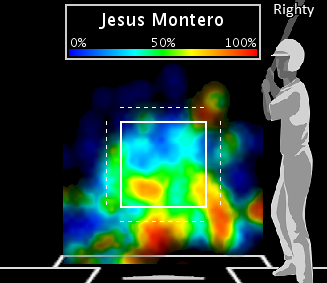Challenge trades involving top young players happen about as often as Halley's Comet sightings, but a bright light shone across the Bronx and the Pacific Northwest last night as Michael Pineda and Jose Campos were traded from the Seattle Mariners to the New York Yankees for Jesus Montero and Hector Noesi.
Pineda, 23 this month and coming off a superb rookie season, didn't come cheap. Montero is just 22 and while the 6-foot-3, 235 pounder has little chance of sticking at catcher over the long haul, he has a career .351 OBP and a .493 slugging percentage at the Triple-A level and raked in a small big league sample in 2011. But in Pineda, the Yankees get five years of team control over a power pitcher with a sinister, if still developing, repertoire.
The 6-foot-7, 260 pound right-hander was almost exclusively a fastball/slider pitcher as a rookie, going to his heater 60 percent of the time and his hard breaking ball 32 percent. His changeup was nearly nonexistent, but Pineda dominated with those two plus-plus pitches.
Pineda threw his fastball at an average speed of 94.3 mph, a mark topped only by Justin Verlander, Alexi Ogando, Felipe Paulino, David Price and Edwin Jackson among starting pitchers. He reached as high as 99.8 mph on the gun and loved to challenge hitters high in the zone with the pitch, trusting that his velocity, big home ball park and quality outfield defense would produce good results. Pineda threw 41 percent of his fastballs high in the strike zone, well above the 35 percent average for starters, and he got a bunch of swings and misses when he climbed the ladder. Take a look at hitters' contact rate by pitch location versus Pineda's fastball, and then the league average:
Opponents' contact rate by pitch location vs. Pineda's fastball, 2011Average contact rate by pitch location vs. fastballs, 2011
Overall, batters missed Pineda's fastball one-fifth of the time that they swung. That ranked in the top 10 among all starters. You'll also note the surprising presence of another Yankee pickup whom we'll look at later today:
Highest fastball miss rate among starting pitchers, 2011
| Player |
Miss Pct. |
| Brandon Beachy |
25.2% |
| Hiroki Kuroda |
22.0% |
| Brandon Morrow |
21.8% |
| Rich Harden |
21.2% |
| Cory Luebke |
20.8% |
| Gio Gonzalez |
20.7% |
| Roy Oswalt |
20.6% |
| David Price |
20.5% |
| Juan Nicasio |
20.3% |
| Michael Pineda |
20.1% |
| League Avg. for SP |
14.4% |
Pineda's second top-shelf offering is a short-breaking mid-80s slider. Many pitchers are reluctant to go to the slider against opposite-handed hitters due to the pitch having a big platoon split (righty starters allowed a .350 slugging percentage on sliders thrown to righties in 2011, and a .386 slugging percentage to lefties), but Pineda had no such qualms. He threw his slider about 27 percent of the time to lefties, and he actually got better results with the pitch against opposite-handed batters:
Pineda's slider vs. right-handed hitters: .191/.226/.313
Pineda's slider vs. left-handed hitters: .155/.212/.268
The key to Pineda's success with the slider against lefties is that he gets them to offer at low-and-inside pitches that practically scrape their shoe tops. Check out left-handed hitters' swing rate against Pineda's slider versus the average for righty starters vs. lefties:
Left-handed hitters' swing rate by pitch location vs. Pineda's slider, 2011Average swing rate by pitch location for lefty hitters vs. right-handed sliders, 2011Lefties chased 39 percent of Pineda's sliders thrown out of the strike zone, one of the top 20 marks among starters and well north of the 33 percent average for righty starting pitchers against left-handed hitters.
Pineda is a great long-term pick up and will pair with CC Sabathia to give the Yankees one of the best one-two combos in the game, but he might face an adjustment period in New York. All of those high fastballs produce lots of fly balls (45 percent, tenth-highest among starters). That played well in Safeco, which reduces home runs hit by lefty hitters by five percent and a whopping 18 percent for righties, but it will likely lead to more long balls in Yankee Stadium, which boosts homers by 43 percent for lefties and 15 percent for righties.
On the positive side, his new outfielders are also swift (the Yankees had the best collective outfield Ultimate Zone Rating last year, due in large part to Brett Gardner) and the change in competition from the AL West to the East might not be as steep as you think. Per Baseball Prospectus, Pineda ranked in the top 15 among pitchers with 150+ innings pitched in opponent on-base-plus slugging percentage, meaning he had one of the toughest slates of batters faced of any starter. Remember, he didn't get the benefit of facing his own worst-in-the majors offense.
Montero could turn into a devastating hitter, but the Yankees managed to add a cheap, ace-caliber pitcher under contract through 2016 without giving up the multi-top prospect premium paid by Washington and Cincinnati for Gio Gonzalez and Mat Latos, respectively. That's a shrewd deal, and one that may well keep the Bombers atop the ultra-competitive AL East.
 David Golebiewski |
David Golebiewski |  Friday, May 24, 2013 at 3:44PM
Friday, May 24, 2013 at 3:44PM



 Mariners | tagged
Mariners | tagged  Jesus Montero,
Jesus Montero,  Seattle Mariners,
Seattle Mariners,  curveball
curveball
